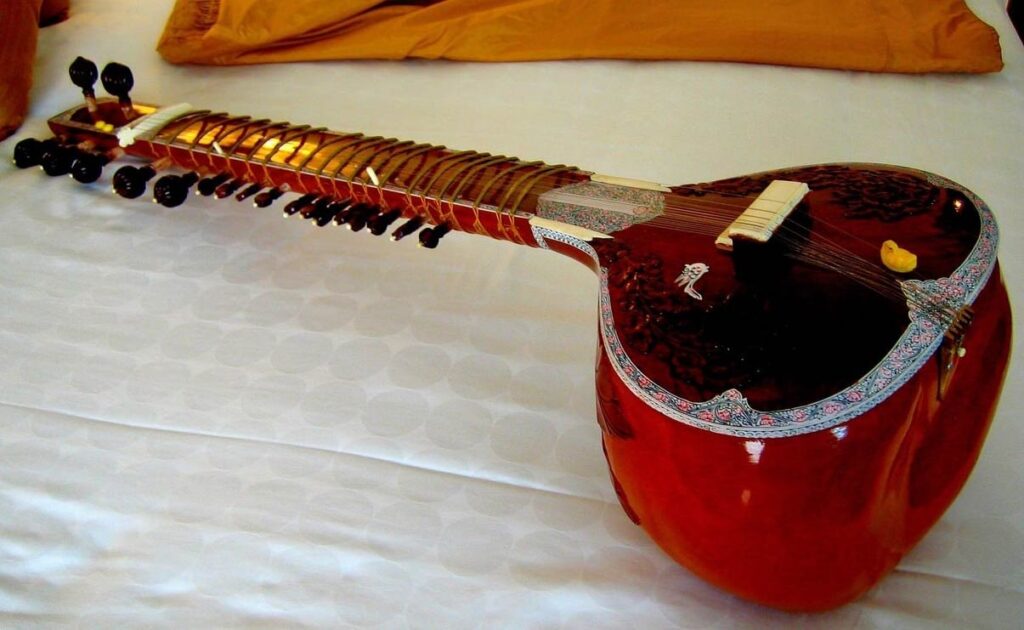The Science Behind the Sitar: Unveiling the Secrets of String Instruments

The sitar, with its mesmerizing melodies and captivating drone, is a cornerstone of Hindustani classical music. Its intricate design and rich history have captivated musicians and audiences for centuries. This guide unravels the mysteries of the sitar, exploring its unique construction, tuning system, and introducing basic music theory concepts relevant to sitar playing. While this serves as a great introduction, consider supplementing it with practical learning at a music academy near you or a music school in India for a more hands-on experience.
Deconstructing the Sitar: A Look at its Design
The sitar’s beauty lies not just in its sound, but also in its intricate craftsmanship. Here’s a breakdown of its key components:
- Main Soundboard (Tumba): Made from gourd or pumpkin, it acts as the primary resonator for the instrument’s sound.
- Neck (Griff): Made of wood, it features frets made of metal or gut. Unlike a guitar, frets on a sitar are movable, allowing for precise tuning of microtones.
- Strings: The sitar has a total of 22 strings, categorized as follows:
- Main Playing Strings (Saat sur): There are 7 strings played with a plectrum (mizrab).
- Drone Strings (Tar taraf): These 4 strings create a continuous background hum.
- Sympathetic Strings (Chikari): These 11 strings vibrate in resonance with the other strings, adding depth and richness to the sound.
- Bridges: Two bridges (jawa and barda) are responsible for transferring string vibrations to the soundboard.
Tuning the Symphony: Understanding the Sitar’s Tuning System
The sitar’s tuning system is based on a concept called “Just Intonation.” Unlike the equal temperament system used in Western music, Just Intonation allows for the creation of pure, perfect intervals. Tuning a sitar requires skill and practice, often involving adjusting the movable frets to achieve the desired microtones specific to a raga.
Music Theory Essentials for Sitar Players
Understanding some basic music theory concepts can significantly enhance your sitar playing journey:
- Scales (Sargams): Similar to scales in Western music, Sarga ms in Indian music define the basic sequence of notes. Learning the notes on the sitar fretboard and practicing different Sargams is crucial.
- Ragas: As mentioned earlier, Ragas are the melodic frameworks that form the foundation of Hindustani classical music. Each Raga has a unique combination of notes and emotions.
- Taals: These are rhythmic cycles that define the rhythmic structure of a composition. Understanding Taals helps you play along with other musicians.
Taking the First Step: Resources and Learning Options
While this guide offers a glimpse into the world of the sitar, there’s so much more to discover! Here are some resources to fuel your sitar learning journey:
- Online Resources: Numerous websites and YouTube channels offer tutorials on sitar basics, finger exercises, and Raga exploration.
- Music Schools in India: Look for reputable music schools in India that specialize in Hindustani classical music and sitar instruction.
- Find a Sitar Guru: A qualified sitar teacher (Guru) can provide personalized guidance, correct your technique, and introduce you to the intricacies of the instrument.
The sitar is a captivating instrument with a rich history and a vibrant future. With dedication, a grasp of music theory, and the guidance of a skilled teacher, you can unlock the secrets of the sitar and embark on a rewarding musical journey.







